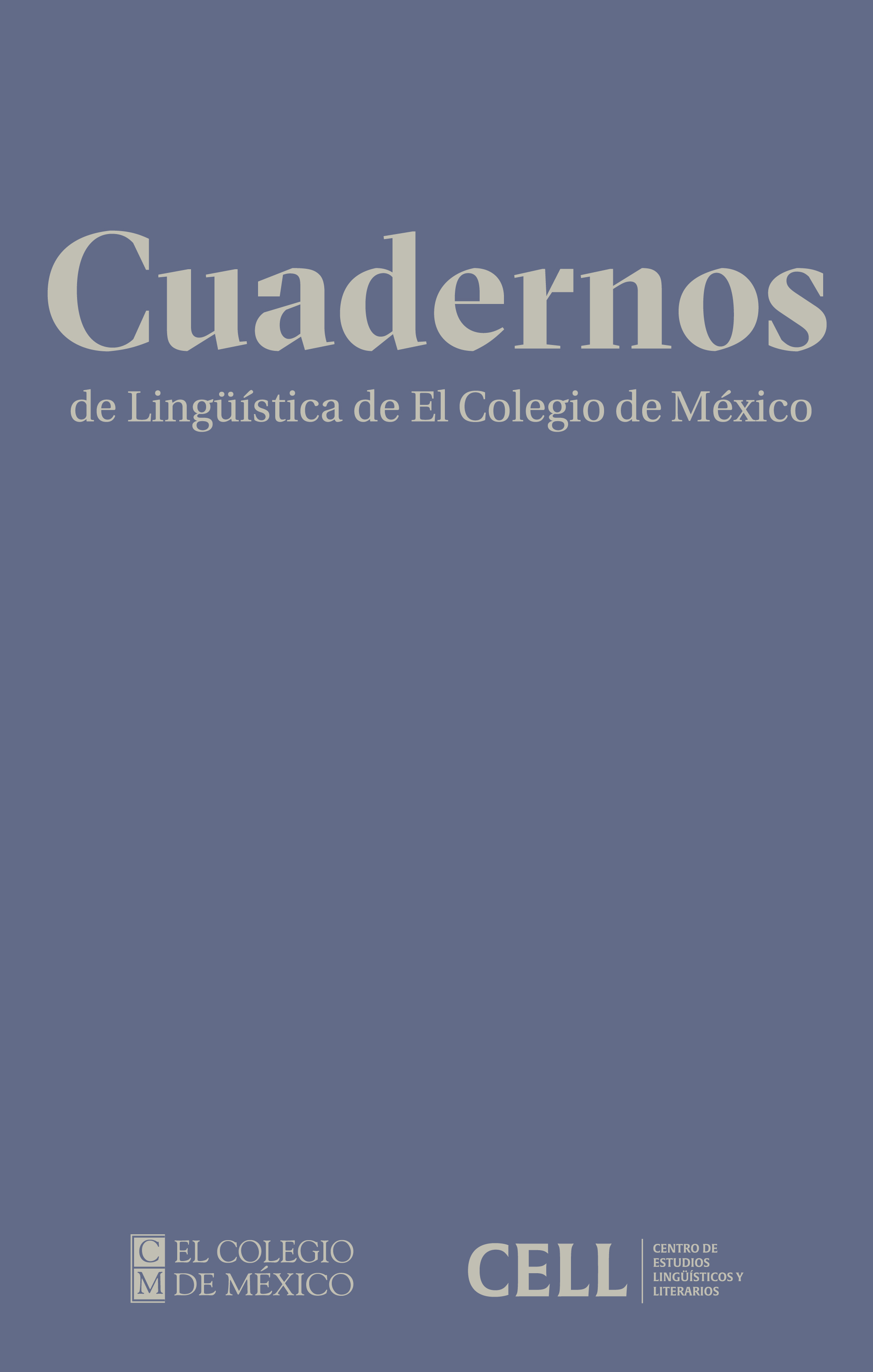On the phonology and origin of the labialized dorsal consonants in Seri
DOI:
https://doi.org/10.24201/clecm.v12.348Keywords:
dorsal consonants, uvular fricative, labialized consonants, historical development, internal reconstructionAbstract
This study examines the phonology and historical development of the labialized dorsal consonants in Seri (Cmiique Iitom), a language of northwestern Mexico. This language has a rare contrast between velar and uvular fricatives, each with labialized counterparts, forming six voiceless dorsal phonemes. It is shown that labialized consonants originated historically through the loss of round vowels in three main contexts: posttonic syllable, the third person indirect object prefix, and the emphatic realis prefix. Phonetic phenomena such as anticipatory labialization and postlexical spread are presented in detail. The study also discusses the Seri orthography, which preserves distinctions critical to the language’s structure.
Downloads
References
Baerman, Matthew. 2016. Seri verb classes: morphosyntactic motivation and morphological autonomy. Language 92(4). 792–823.
Bancroft, Hubert Howe. 1886. Myths and languages. Vol. 3, The native races of the Pacific states of North America. San Francisco: The History Company.
Bartlett, John R. 1852. Vocabulary of the ‘Ceris’. Bureau of American Ethnology collection (uan: nmnh1627_025), National Anthropological Archives, Smithsonian Institution, Washington. Manuscript.
Butler H., Inez M. 1980. Gramática zapoteca: zapoteco de Yatzachi el Bajo. Mexico City: Instituto Lingüístico de Verano. https://mexico.sil.org/resources/archives/1322
Eberhard, David M. & Simons, Gary F. & Fennig, Charles D. (eds.). 2025. Ethnologue: Languages of the world. Dallas: SIL International. http://www.ethnologue.com
Fernández de Miranda, María Teresa. 1995 [1965]. El protozapoteco. Mexico City: El Colegio de México, Centro de Estudios Lingüísticos y Literarios & Instituto Nacional de Antropología e Historia.
Gil Burgoin, Carlos Ivanhoe. 2014. Reconstrucción del sistema consonántico del proto-yumano de California y delta del Colorado. Cuadernos de Lingüística de El Colegio de México 2. 195–238.
Haspelmath, Martin & Dryer, Matthew S. & Gil, David & Comrie, Bernard (eds.). 2008. The World Atlas of Language Structures Online. http://wals.info
Heaton, Raina. 2018. Language isolates of Mesoamerica and northern Mexico. In Campbell, Lyle (ed.), Language isolates, 229–259. London: Routledge.
Hernández, Fortunato. 1902. Lengua seri o kunkáak. In Hernández, Fortunato (ed.), Las razas indígenas de Sonora y la guerra del Yaqui, 237–294. Mexico City: Casa Editorial J. De Elizalde. http://cdigital.dgb.uanl.mx/la/1080013243/1080013243.html
INALI (Instituto Nacional de Lenguas Indígenas). 2019. Cmiique iitom coi ziix quih iti cöpahpacta cöispaspoj hac: norma de escritura de la lengua cmiique iitom (seri). Mexico City: Secretaría de Cultura, Instituto Nacional de Lenguas Indígenas. https://site.inali.gob.mx/Micrositios/ normas/seri.html
IPA (International Phonetic Association). 1999. Handbook of the International Phonetic Association. Cambridge: Cambridge University Press.
Marlett, Stephen A. 1981a. The abstract consonant in Seri. Proceedings of the Berkeley Linguistics Society. 154–165.
Marlett, Stephen A. 1981b. The structure of Seri. Doctoral dissertation. La Jolla. University of California at San Diego.
https://mexico.sil.org/resources/archives/9917
Marlett, Stephen A. 1990. Person and number inflection in Seri. International Journal of American Linguistics 56(4). 503–541.
Marlett, Stephen A. 2008. Stress, extrametricality and the minimal word in Seri. Linguistic Discovery 6.1. 114. http://journals.dartmouth.edu/cgibin/WebObjects/Journals.woa/1/xmlpage/1/article/321
Marlett, Stephen A. 2010. The nineteenth-century Seri word lists: comparison and analysis. SIL-Mexico Branch Electronic Working Papers 8. 1–61. https://mexico.sil.org/resources/archives/56726
Marlett, Stephen A. 2012. Relative clauses in Seri. In Comrie, Bernard & Estrada-Fernández, Zarina. (eds.), Relative clauses in languages of the Americas: a typological overview, 213–242. Amsterdam: John Benjamins.
Marlett, Stephen A. 2024. A bibliography for the study of Seri history, language and culture. 3rd edn. Oaxaca: Instituto Lingüístico de Verano. https://mexico.sil.org/resources/archives/94401
Marlett, Stephen A. in preparation. The Seri language: a comprehensive description. Manuscript.
Marlett, Stephen A., F. & Moreno Herrera, F. Xavier & Herrera Astorga, Genaro G. 2005. Seri. Journal of the International Phonetic Association 35(1). 117–121.
Miller, Amy. 2018. Phonological developments in Delta-California Yuman. International Journal of American Linguistics 84(3). 383433. https://doi.org/10.1086/697588
Moran, Steven & McCloy, Daniel (eds.). 2019. phoible 2.0. Jena: Max Planck Institute for the Science of Human History. http://phoible.org
Moser, Edward W. 1961. Number in Seri verbs. Master’s thesis. Phila- delphia. University of Pennsylvania. https://www.sil.org/resources/archives/100870
Moser, Edward W. & Moser, Mary B. 1961. Vocabulario seri. Mexico City: Instituto Lingüístico de Verano.
Moser, Edward W. & Moser, Mary B. 1965. Consonant–vowel balance in Seri (Hokan) syllables. Linguistics: An International Review 16. 50–67.
Moser, Edward W. & Moser, Mary B. 1976. Seri noun pluralization class- es. In Langdon, Margaret & Silver, Shirley (eds.), Hokan studies, 285–296. The Hague: Mouton.
Moser, Mary B. & Marlett, Stephen A. 2005. Comcáac quih yaza quih hant ihíip hac: diccionario seri–español–inglés. Mexico City & Hermosillo: Plaza y Valdés Editores & Universidad de Sonora.
Moser, Mary B. & Marlett, Stephen A. 2010. Comcaac quih yaza quih hant ihiip hac: diccionario seri–español–inglés. 2nd edn. (Colección Bicentenario). Mexico City & Hermosillo: Plaza y Valdés Editores & Universidad de Sonora. http://mexico.sil.org/resources/archives/42821
Operstein, Natalie. 2010. Consonant structure and prevocalization. Amsterdam: John Benjamins.
Pajeken, Clemens A. & Ruperti, Friedrich. 1861. Reise–Erinnerungen und Abenteuer aus der neuen Welt in ethnographischen Bildern. Bremen: Heyse.
Pinart, Alphonse. 1879. [Vocabulary of the Seri]. Washington: Bureau of American Ethnology collection, National Anthropological Archives, Smithsonian Institution. Manuscript.
Romero Astorga, Pedro. 1995. Knoíki íitom: lengua seri de Sonora, primer ciclo, parte 1. Mexico City: Dirección General de Educación Indígena de la Subsecretaría de Educación Básica y Normal de la Secretaría de Educación Pública.
Smith-Stark, Thomas. 2007. Algunas isoglosas zapotecas. In Buenrostro, Cristina & Herrera Castro, Samuel & Lastra, Yolanda & Nava, Fernando & Rendón, Juan José & Schumann, Otto & Valiñas, Leopoldo & Vargas Monroy, María Aydeé (eds.), Clasificación de las lenguas indígenas de México: memorias del III Coloquio Internacional de Lingüística Mauricio Swadesh, 69–133. Mexico City: Universidad Nacional Autónoma de México & Instituto de Investigaciones Antropológicas & Instituto Nacional de Lenguas Indígenas.
Stemberger, Joseph P. & Marlett, Stephen A. 1983. Empty consonants in Seri. Linguistic Inquiry 14(4). 617–639.
Zhivlov, Mikhail. 2024. Hokan I: a review of comparative studies. Journal of Language Relationship 22(12). 162–188.
Downloads
Published
How to Cite
-
Abstract218
-
PDF (Español)104
-
XML (Español)3
Issue
Section
License
Copyright (c) 2025 Stephen Marlett

This work is licensed under a Creative Commons Attribution-NonCommercial 4.0 International License.
Authors retain copyright of their work and are free to disseminate it, make copies for any use, and/or deposit in any repository or archive of their choice, but they grant Cuadernos de Lingüística de El Colegio de México the right to publish the work for the first time. Authors agree to acknowledge Cuadernos de Lingüística de El Colegio de México as the site of original publication of their article / note / review through proper citation.
Articles appearing in Cuadernos de Lingüística de El Colegio de México are made available to readers under a Attribution-NonCommercial-NoDerivatives 4.0 International.









